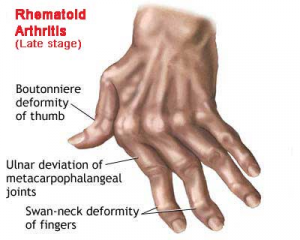Seasonal Variation in Rheumatoid Arthritis
This article is currently under review and may not be up to date. Please come back soon to see the finished work! (5/01/2023)
Introduction[edit | edit source]
Rheumatoid arthritis (RA) is a chronic, immuno-inflammatory disease that involves the immune system attacking its own tissues. It mainly affects the lining of the hand, wrist, and knee joints. This causes pain, swelling, stiffness, deformity and unsteadiness at the level of the joint[1]. The cause of rheumatoid arthritis is unknown however, it is thought to be triggered by smoking, genes, and infections[2]. Although cold weather does not cause arthritis, RA patients tend to complain of an exacerbation of pain and ache during the winter season[3].
Influence of Seasonal Parameters on Joints[edit | edit source]
The seasonal parameters - atmospheric pressure, temperature and humidity have known to cause a flare-up in RA or trigger the disease.
Atmospheric Pressure
It's force exerted by the atmosphere at a given point. It varies at different altitudes from sea level. The atmospheric pressure changes with change in seasons.[4] This increase or decrease causes the tendons, muscles, and any scar tissue expand and contract, and that can create pain in joints affected by arthritis.The Arthritis Foundation published a study from Tufts University in 2007 that found that every 10-degree drop in temperature corresponded with an incremental increase in arthritis pain.[5]
Humidity
High humidity levels can cause sweating and dehydration which can make the blood thicker, which increases blood pressure in the blood vessels and makes the body work more to pump blood through the body which can decrease the concentration of fluid around the joints and create more joint pain. The classic opinion, "Cold and wet is bad, warm and dry is good for RA patients," seems to be true only as far as humidity is concerned.[6]
Temperature
It has been speculated that changes in temperature changes the thickness of joint fluids i.e. Low temperatures may also increase the thickness of joint fluids, making them stiffer and perhaps more sensitive to pain during movement.[5][7]
All the above factors together initiate various immunological responses in RA. A change in season causes a rise in level of IgG antibodies (Rheumatoid factor), thereby triggering the RA inflammatory mechanism in the body.[8]
Role of Physiotherapy[edit | edit source]
- As physiotherapist have a long term follow up with RA patients, they can document the seasonal parameters using various weather apps during which the patient experiences pain.Depending on these records we can predict when will there will be next trigger of RA and pre-plan the treatment.[9][10]
- As per the protocol patient can be recommended various exercises before the onset of RA reducing the pain and stiffness. For example the patient might experience pain whenever the pressure is 1002 mbar, humidity at 17% and temperature 41 degrees, so we can alert the patient whenever these conditions are reached and take preventative measures.
- Pneumatic pressure pumps have been found useful in reducing pain and swelling during seasonal flare up.
- Alternatively the patient can be asked to change the location whenever the weather conditions turn unfavorable.
Resources[edit | edit source]
Can the weather really worsen arthritis pain
References[edit | edit source]
- ↑ Rheumatoid arthritis. National Institute of Arthritis and Musculoskeletal and Skin Diseases. U.S. Department of Health and Human Services. Available from: https://www.niams.nih.gov/health-topics/rheumatoid-arthritis (accessed 5/1/2023)
- ↑ Rheumatoid arthritis (RA): Causes, symptoms & treatment. Cleveland Clinic. Available from: https://my.clevelandclinic.org/health/diseases/4924-rheumatoid-arthritis (accessed 5/1/2023)
- ↑ Paturel A. Why is Arthritis Worse in the Winter? [Internet]. Cedars Sinai. 2022 [cited 5 January 2023]. Available from: https://www.cedars-sinai.org/blog/arthritis-worse-in-winter-winter.html
- ↑ Arthritis Foundation. Weather and Arthritis Pain. Available from: http://blog.arthritis.org/living-with-arthritis/weather-arthritis-pain/ (accessed 09/02/2020).
- ↑ 5.0 5.1 Terao C, Hashimoto M, Furu M, Nakabo S, Ohmura K, Nakashima R, Imura Y, Yukawa N, Yoshifuji H, Matsuda F, Ito H. Inverse association between air pressure and rheumatoid arthritis synovitis. PloS one 2014;9(1).
- ↑ Patberg WR, Rasker JJ. Weather effects in rheumatoid arthritis: from controversy to consensus. A review. The Journal of rheumatology 2004;31(7):1327-34.
- ↑ Abasolo L, Tobías A, Leon L, Carmona L, Fernandez-Rueda JL, Rodriguez AB, Fernandez-Gutierrez B, Jover JA. Weather conditions may worsen symptoms in rheumatoid arthritis patients: the possible effect of temperature. Reumatología Clínica (English Edition) 2013;9(4):226-8.
- ↑ Terao C, Ohmura K, Yamamoto K, Yukawa N, Kawabata D, Nojima T, Fujii T, Mimori T. Serum IgG levels demonstrate seasonal change in connective tissue diseases: a large-scale, 4-year analysis in Japanese. Modern rheumatology 2012;22:426-30.
- ↑ Physiopedia. Whole-body cryotherapy. Available from: https://www.physio-pedia.com/Whole-body_cryotherapy(accessed 09/02/2020).
- ↑ Physiopedia. Aquatherapy. Available from: https://www.physio-pedia.com/Aquatherapy (accessed 09/02/2020).







